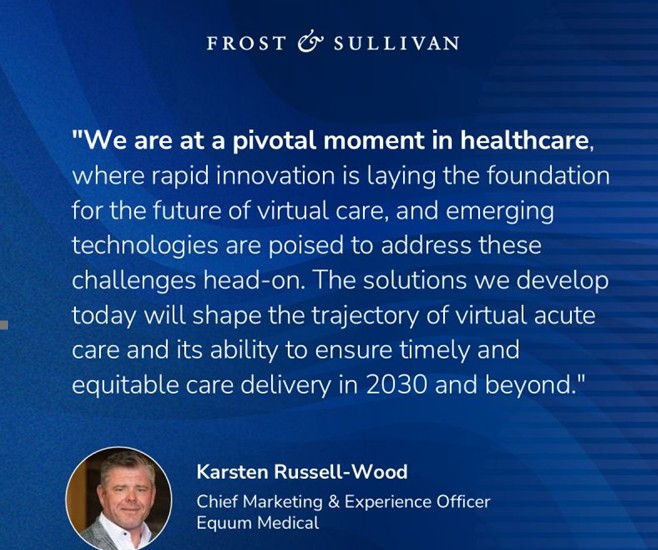The healthcare industry is in the midst of a transformation as hospitals and health systems expand their approach to virtual acute care. With the growing adoption of both in-hospital virtual care solutions and hospital-at-home programs, providers are now tasked with caring for acutely ill patients in new ways.
In a recent Frost & Sullivan webinar, leading experts discussed whether government budgets would continue to support reimbursement for these innovative care models, how the vendor ecosystem is evolving, and the growth of hybrid vendors that address both platform- and staffing challenges associated with virtual acute care.
Watch the Webinar On-Demand:
Gain deeper insights from industry leaders and stay ahead of healthcare’s rapid transformation. Click here to access the recorded session.
Featured Experts:
- Greg Caressi – Growth Coach & Senior Vice President, Frost & Sullivan
- Nitin Manocha – Growth Expert & Senior Industry Analyst, Frost & Sullivan
- Karsten Russell-Wood – Chief Marketing & Experience Officer, Equum Medical
- Sarah Quiring – Product Manager, AvaSure
Key Takeaways from the Discussion
- Virtual Acute Care Delivery
- In-Hospital Virtual Care: A major focus of the discussion was on how hospitals are integrating virtual care solutions to support acutely ill patients. Advanced monitoring systems and operational protocols are being deployed to optimize patient flow and resource allocation within hospital settings.
- Shift in Care Delivery: Healthcare providers are expanding care beyond hospital walls, enabling acutely ill patients to receive critical services in the comfort of their homes while optimizing hospital resource utilization.
- The Hospital-at-Home Model and Telehealth Are Here to Stay—But Face Challenges
- Short-Term Uncertainty: Recent policy extensions have temporarily supported telehealth and hospital-at-home adoption; however, long-term regulations remain unclear, impacting how hospital systems plan their virtual care infrastructure investments.
- Consumer Expectations: With increasing digital engagement from Gen X and Millennials, consumers expect convenient, digital-first care. This demand will likely push hospitals and policymakers toward broader adoption of virtual care solutions.
- Payviders: Integrated Payer-Provider (payvider) systems will have an upper hand as they manoeuvre the changing reimbursement environment with more agility.
- Hybrid Business Model Is the Key for Success
- Platform vs. Staffing Model Approach: Experts discussed the merits of technology-centric platforms versus hybrid models that combine digital solutions with dedicated staffing. The consensus highlights that aligning clinical teams with robust technological infrastructure is essential for delivering effective virtual acute care.
- AI & Wearable Technology are Revolutionizing Remote Patient Monitoring
- Advancements in AI & Wearables: AI-driven solutions and long-duration wearable devices are enabling continuous, real-time monitoring for patients outside of traditional settings, providing valuable insights into patient status with minimal manual intervention.
- The Role of AI in Virtual Acute Care Regulation
- Data Protection & Compliance: Ensuring patient data privacy and maintaining compliance with regulations (such as HIPAA in the US) is a top priority as AI-driven healthcare solutions are deployed.
- Global vs. Local Vendors: While some regions favor local vendors that adhere to specific data protection laws, broader interoperability initiatives—like the EU Health Data Space—are working toward standardizing data sharing across healthcare systems.
- The Telehealth Revolution Is Global and Unstoppable
- Post-Pandemic Shift: The pandemic dismantled longstanding regulatory barriers in many regions, with telehealth now becoming a key component of care delivery worldwide.
- Sustained Growth: Despite short-term uncertainties regarding policy and reimbursement, the overall momentum of virtual care is unlikely to diminish, driven by its clear benefits to providers and patients alike.


Final Thoughts: The Future of Acute Virtual Care & Hospital-at-Home Programs
The healthcare industry is at a critical inflection point. While regulatory uncertainties—particularly around government reimbursement—pose challenges, technological advancements in AI, remote monitoring, and integrated virtual care platforms continue to open new opportunities. By embracing both in-hospital virtual care solutions and hospital-at-home models, health systems can enhance care delivery for acutely ill patients while optimizing operational efficiency. The future of virtual acute care will depend on successful collaborations between hospital systems, technology vendors, and policy makers to create a secure, effective, and patient-centered ecosystem.
Is your organization prepared to embrace these opportunities in acute virtual care?



